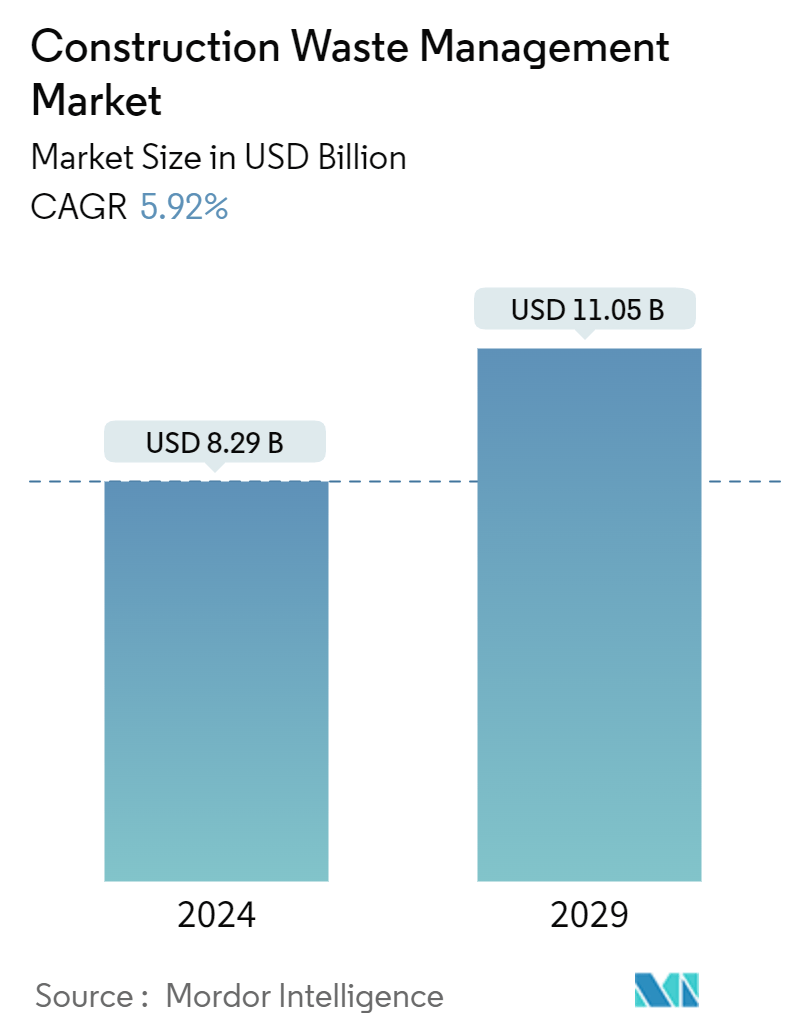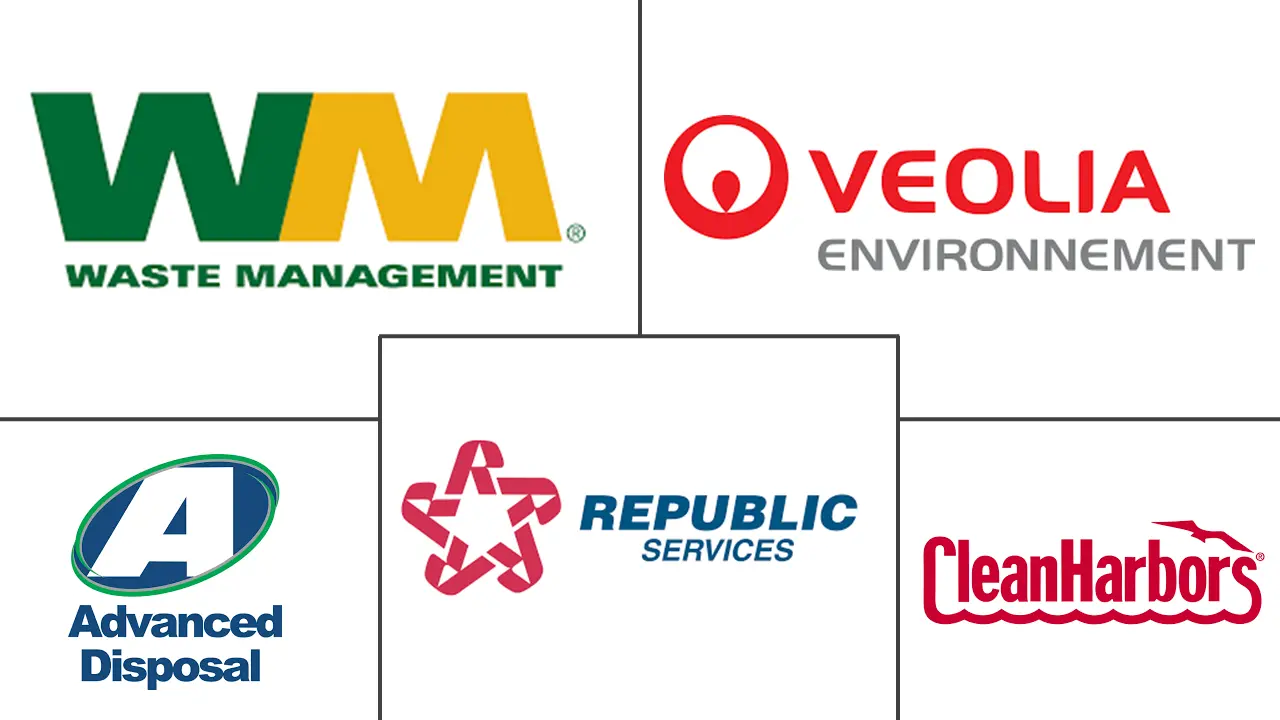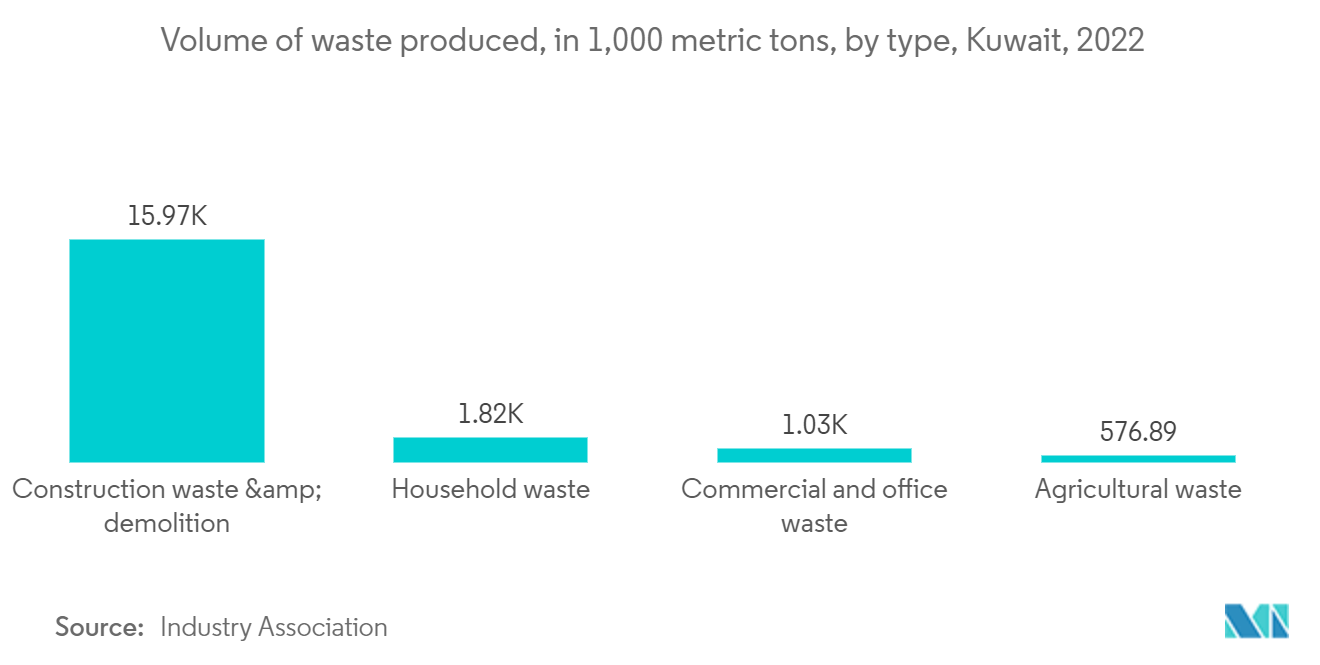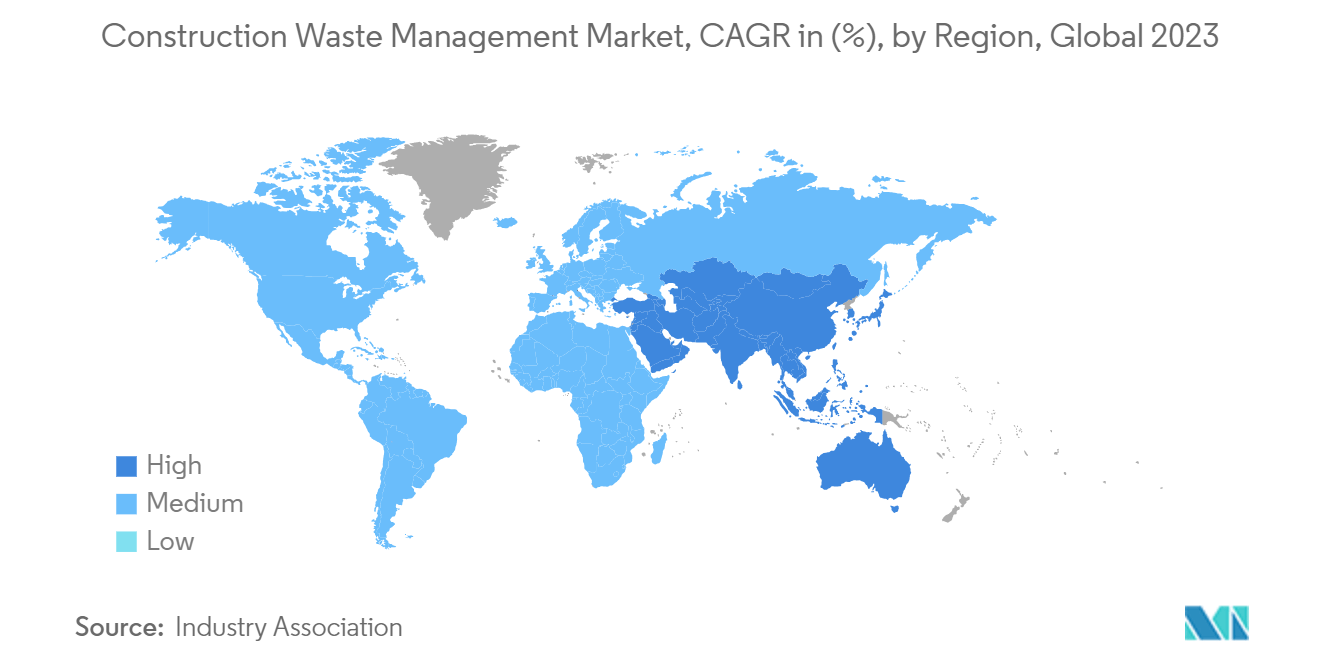Construction Waste Management Market Size

| Study Period | 2020 - 2029 |
| Market Size (2024) | USD 8.29 Billion |
| Market Size (2029) | USD 11.05 Billion |
| CAGR (2024 - 2029) | 5.92 % |
| Fastest Growing Market | Asia Pacific |
| Market Concentration | High |
Major Players
*Disclaimer: Major Players sorted in no particular order |
Construction Waste Management Market Analysis
The Construction Waste Management Market size is estimated at USD 8.29 billion in 2024, and is expected to reach USD 11.05 billion by 2029, growing at a CAGR of 5.92% during the forecast period (2024-2029).
- Rapid urbanization and a growing emphasis on sustainability are the primary drivers of the construction waste management market. Currently, over 75% of construction material waste remains unrecycled despite its inherent value. In 2018, the Environmental Protection Agency (EPA) highlighted that construction waste doubled that of municipal waste from both households and businesses. The United States leads globally in household waste generation.
- The construction and demolition (C&D) waste category spans materials like concrete, asphalt, wood, brick, clay tiles, gypsum drywall, asphalt shingles, and metal. While concrete and metal are readily recyclable, others, especially brick, clay tiles, and gypsum drywall, face reusability challenges, often ending up in landfills.
- In India, amid rapid urbanization, the construction sector is increasingly recognized as a key source of air pollution and a substantial consumer of resources. Notably, India's resource extraction rate, at 1,580 tonnes per acre, far exceeds the global average of 450 tonnes per acre.
- The National Clean Air Programme has set a stringent target for the 131 non-attainment cities in India: a 40% reduction in particulate pollution by 2026. Consequently, effective management of construction and demolition (C&D) waste has become paramount in curbing pollution levels.
- However, a recent CSE review highlights a concerning trend: many cities lack the institutional readiness for systematic and scientific C&D waste management. Moreover, the adoption of the C&D Waste Management Rules of 2016 has been sluggish, with noticeable gaps in their execution. This underscores the urgent need for comprehensive guidance to enhance both the understanding of the system's design and the strategies for its effective implementation.
- Despite hurdles, the construction sector has shown progress in sustainability, managing to repurpose more than 75% of its waste. Notably, recycling activities account for over 85% of waste management jobs, underscoring their significance, especially when considering that the United States recycles only a third of its total waste output.
- With regulatory bodies and construction companies intensifying their efforts to curb waste, the construction waste management market is set for expansion. Approaches like lean construction and value engineering are honing in on waste reduction from the project's inception, while post-planning services are offering efficient waste removal and disposal solutions.
Construction Waste Management Market Trends
Residential Construction Waste Holds a Significant Share of the Market
Residential construction waste is a significant contributor to the global construction debris challenge, emphasizing the urgency of effective waste management. Projections suggest that annual construction waste worldwide will escalate to 2.2 billion tons by 2025, largely driven by residential projects and renovations.
Within the United States, construction and demolition (C&D) debris, including residential waste, constitute a striking 25% of the nation's total waste output. This statistic not only underscores the substantial waste from residential endeavors but also highlights the significant contributions from commercial and institutional construction.
Common materials in residential construction waste encompass wood, drywall, concrete, and packaging materials. Alarmingly, around 30% of materials delivered to construction sites end up as waste, accentuating the sector's material inefficiency.
The ramifications of unmanaged construction waste are dire, leading to environmental pollution and resource depletion. Ecosystem disruptions and subsequent pollution can have far-reaching consequences, affecting both wildlife and public health.
Embracing sustainable practices, like material recycling and reusing, presents a viable solution to curbing the surge in residential construction waste. Strategies such as lean construction and robust waste management plans hold promise in significantly reducing waste output during residential endeavors.

Asia-Pacific Holds a Significant Share of the Market
Construction waste management practices in Asia exhibit significant disparities across nations. Countries like Japan, Hong Kong, and Singapore stand out for their advanced systems, emphasizing recycling and proper disposal. South Korea boasts an impressive recycling rate exceeding 97%, while Taiwan has also made strides, surpassing a 50% recycling rate. In contrast, many developing nations grapple with low recycling rates, often resorting to open dumping, a practice laden with challenges.
Asia's regulatory landscape for construction waste management is diverse, with a common thread: a focus on local authorities' responsibilities. Notably, countries like India are enacting regulations to bolster oversight of waste management practices. These regulations, part of comprehensive acts, aim to enhance compliance and efficiency in handling construction waste.
Despite progress, Asia faces persistent challenges in construction waste management. Issues range from funding shortages and a lack of standardized practices to illegal dumping and inadequate waste processing infrastructure. Moreover, informal waste industries and complex governmental responsibilities further hinder effective waste management, particularly in developing nations.
Looking forward, Asia's construction waste management market is set for growth. This trajectory is fueled by rising urbanization and an amplified focus on sustainability. Anticipated innovations in recycling technologies, coupled with stricter regulations, are poised to significantly boost recycling rates. Moreover, increased collaboration between construction firms and waste management entities is expected to bolster compliance with waste management standards and foster a circular economy.

Construction Waste Management Industry Overview
The construction waste management market is fragmented in nature. Several key players are competing to provide efficient and sustainable waste management solutions for construction projects. Some notable companies in this space include Waste Management, Veolia Environment, Clean Harbors, Republic Services, and Advanced Disposal Services. These companies offer a range of services such as waste collection, recycling, landfill management, and environmental consulting to help construction firms effectively manage their waste while adhering to regulatory requirements and environmental standards.
Construction Waste Management Market Leaders
-
Waste Management
-
Veolia Environment
-
Clean Harbors
-
Republic Services
-
Advanced Disposal Services
*Disclaimer: Major Players sorted in no particular order

Construction Waste Management Market News
July 2024: Sortera, a leader in recycling and processing residual products from the building and construction industries in Northern Europe, announced that it was bolstering its presence in Greater London's construction waste market through the acquisition of Reston Waste Management Ltd. Reston Waste stands out as one of South West London's prominent independent waste management firms.
July 2024: Holcim, a key player in construction, completed its acquisition of Land Recovery in the United Kingdom. This strategic move enhances Holcim's standing in circular construction. With this deal, Holcim expanded its portfolio, particularly in construction demolition materials, leveraging Land Recovery's track record of recycling over 300,000 tons in 2023.
Construction Waste Management Market Report - Table of Contents
1. INTRODUCTION
- 1.1 Study Assumptions
- 1.2 Scope of the Study
2. RESEARCH METHODOLOGY
- 2.1 Analysis Methodology
- 2.2 Research Phases
3. EXECUTIVE SUMMARY
4. MARKET DYNAMICS AND INSIGHTS
- 4.1 Current Market Scenario
-
4.2 Market Dynamics
- 4.2.1 Drivers
- 4.2.1.1 Urbanization and Population Growth Driving the Market
- 4.2.1.2 Economic Growth Driving the Market
- 4.2.2 Restraints
- 4.2.2.1 Regulatory Frameworks Affecting the Market
- 4.2.2.2 High Costs Associated with the Recycling Process Affecting the Market
- 4.2.3 Opportunities
- 4.2.3.1 Technological Advancements Driving the Market
- 4.3 Value Chain/Supply Chain Analysis
-
4.4 Industry Attractiveness - Porter's Five Forces Analysis
- 4.4.1 Bargaining Power of Suppliers
- 4.4.2 Bargaining Power of Consumers
- 4.4.3 Threat of New Entrants
- 4.4.4 Threat of Substitute Products
- 4.4.5 Intensity of Competitive Rivalry
- 4.5 Technological Developments in the Waste Recycling Services Market
- 4.6 Impact of COVID-19 on the Market
5. MARKET SEGMENTATION
-
5.1 By Waste Type
- 5.1.1 Hazardous
- 5.1.2 Non-hazardous
-
5.2 By Source
- 5.2.1 Residential
- 5.2.2 Non-residential
-
5.3 By Material
- 5.3.1 Concrete & Bricks
- 5.3.2 Wood
- 5.3.3 Metal
- 5.3.4 Plastics
- 5.3.5 Glass
- 5.3.6 Other Materials (Soil, Drywall, Plaster, etc.)
-
5.4 By Geography
- 5.4.1 North America
- 5.4.1.1 United States
- 5.4.1.2 Canada
- 5.4.1.3 Mexico
- 5.4.1.4 Rest of North America
- 5.4.2 Europe
- 5.4.2.1 United Kingdom
- 5.4.2.2 Germany
- 5.4.2.3 France
- 5.4.2.4 Russia
- 5.4.2.5 Italy
- 5.4.2.6 Spain
- 5.4.2.7 Rest of Europe
- 5.4.3 Asia-Pacific
- 5.4.3.1 India
- 5.4.3.2 China
- 5.4.3.3 Japan
- 5.4.3.4 Australia
- 5.4.3.5 Rest of Asia-Pacific
- 5.4.4 South America
- 5.4.4.1 Brazil
- 5.4.4.2 Argentina
- 5.4.4.3 Rest of South America
- 5.4.5 Middle East and Africa
- 5.4.5.1 United Arab Emirates
- 5.4.5.2 South Africa
- 5.4.5.3 Rest of Middle East and Africa
6. COMPETITIVE LANDSCAPE
- 6.1 Market Concentration Overview
-
6.2 Company Profiles
- 6.2.1 Waste Management
- 6.2.2 Veolia Environment
- 6.2.3 Clean Harbors
- 6.2.4 Republic Services
- 6.2.5 Advanced Disposal Services
- 6.2.6 Biffa
- 6.2.7 Covanta Holding
- 6.2.8 Daiseki
- 6.2.9 Hitachi Zosen
- *List Not Exhaustive
- 6.3 Other Companies*
7. FUTURE OF THE MARKET
8. APPENDIX
- 8.1 Macroeconomic Indicators
- 8.2 Insights into Capital Flows (Investments in Construction Sector)
- 8.3 External Trade Statistics
Construction Waste Management Industry Segmentation
The construction waste management market deals with the collection, transportation, recycling, and disposal of waste produced during construction. This waste includes concrete, wood, metals, and other materials.
The construction waste management market is segmented by waste type (hazardous and non-hazardous), source (residential and non-residential), material (concrete & bricks, wood, metal, plastics, glass, and other materials (soil, drywall, plaster, etc.)), and geography (North America, Europe, Asia-Pacific, South America, and the Middle East and Africa). The report offers market sizes and forecasts in value (USD) for all the above segments.
Construction Waste Management Market Research FAQs
How big is the Construction Waste Management Market?
The Construction Waste Management Market size is expected to reach USD 8.29 billion in 2024 and grow at a CAGR of 5.92% to reach USD 11.05 billion by 2029.
What is the current Construction Waste Management Market size?
In 2024, the Construction Waste Management Market size is expected to reach USD 8.29 billion.
Who are the key players in Construction Waste Management Market?
Waste Management, Veolia Environment, Clean Harbors, Republic Services and Advanced Disposal Services are the major companies operating in the Construction Waste Management Market.
Which is the fastest growing region in Construction Waste Management Market?
Asia Pacific is estimated to grow at the highest CAGR over the forecast period (2024-2029).
What years does this Construction Waste Management Market cover, and what was the market size in 2023?
In 2023, the Construction Waste Management Market size was estimated at USD 7.80 billion. The report covers the Construction Waste Management Market historical market size for years: 2020, 2021, 2022 and 2023. The report also forecasts the Construction Waste Management Market size for years: 2024, 2025, 2026, 2027, 2028 and 2029.
Construction Waste Management Industry Report
Statistics for the 2024 Construction Waste Management market share, size and revenue growth rate, created by Mordor Intelligence™ Industry Reports. Construction Waste Management analysis includes a market forecast outlook for 2024 to 2029 and historical overview. Get a sample of this industry analysis as a free report PDF download.



